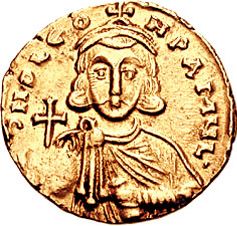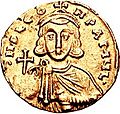Pope Gregory II facts for kids
Quick facts for kids Pope Saint Gregory II |
|
|---|---|
| Bishop of Rome | |
| Church | Catholic Church |
| Papacy began | 19 May 715 |
| Papacy ended | 11 February 731 |
| Predecessor | Constantine |
| Successor | Gregory III |
| Personal details | |
| Birth name | Gregorius Sabellus |
| Born | 669 Rome, Exarchate of Ravenna, Eastern Roman Empire |
| Died | 11 February 731 (aged c. 62) Rome, Exarchate of Ravenna, Eastern Roman Empire |
| Sainthood | |
| Feast day | 11 February |
| Venerated in | Catholic Church |
| Attributes |
|
| Other Popes named Gregory | |
Pope Gregory II (born 669 – died 11 February 731) was the leader of the Catholic Church and Bishop of Rome from 715 until his death. He is famous for standing up to Emperor Leo III the Isaurian. This disagreement was over the use of religious images (icons) in the Eastern Empire. His actions helped lead to the popes gaining more political power in Italy.
Contents
Early Life and Becoming Pope
Gregory was born in Rome in 669 to a noble family. His parents were Marcellus and Honesta. As a young man, he started working for the pope. He became a subdeacon and later a deacon. He was also put in charge of the Vatican Library.
In 711, Gregory traveled with Pope Constantine to Constantinople. They went to discuss disagreements about church laws. Gregory helped negotiate with Emperor Justinian II. The emperor agreed that the pope could choose which church decisions to follow.
After Pope Constantine died in 715, Gregory was chosen as the new pope. He became the Bishop of Rome on May 19, 715.
First Years and Spreading Christianity
Soon after becoming pope, Gregory started repairing Rome's old city walls. This work was paused in 716 when the Tiber River flooded Rome. The flood caused a lot of damage. Gregory prayed for the floods to stop, and they did after eight days.
In 716, Duke Theodo of Bavaria visited Gregory. They talked about converting Bavaria to Christianity. Gregory sent helpers to Bavaria to set up a church system there. He also made Corbinian a bishop of Freising in Bavaria.
Gregory also focused on Germany. In 718, he met Winfrid, an Anglo-Saxon missionary. Gregory approved Winfrid's plan to preach in Germany. He changed Winfrid's name to Boniface. In 719, Gregory sent Boniface to Germany.
Later, Gregory called Boniface back to Rome in 722. There were rumors about Boniface's beliefs. Gregory was satisfied after talking with Boniface. He made Boniface a bishop and sent him back to Germany. Gregory continued to support Boniface's work in Germany.
Gregory also made the pope's power stronger in Britain and Ireland. In 726, Ine, a former king, visited Rome. He had given up his throne to make a pilgrimage and live out his life there.
Church Activities in Rome
Gregory worked to establish and restore monasteries. He turned his family home in Rome into a monastery. He also built a new church. In 718, he helped restore Monte Cassino, a monastery destroyed by the Lombards.
In 721, Gregory held a meeting of church leaders in Rome. They discussed rules for marriage. He also settled a long-running dispute between two church leaders in Italy. Gregory made sure bishops were chosen according to church law.
Gregory also set new rules for church practices. He said people should fast on Thursdays during Lent. Before this, some people avoided it because pagans used to fast on Thursdays.
Relations with the Lombards
Gregory tried to keep peace with the Lombards, a Germanic people in Italy. He had a good relationship with their king, Liutprand. In 716, Gregory convinced Liutprand not to take back some land given to the Church.
However, a Lombard duke named Romuald II captured Cumae in 717. This cut off Rome from Naples. Gregory asked Duke John I of Naples for help. John successfully retook Cumae.
In 717, another Lombard duke captured the port of Ravenna. Gregory made a deal with King Liutprand. Liutprand forced the duke to return the port. Gregory saw that the Lombards were slowly taking over imperial land in Italy. Around 721, he asked the Franks for help, but they did not respond.
In 727, the Lombards captured and destroyed the port of Classis again. They also took over other areas. Gregory helped make a temporary peace deal between the Lombards and the Byzantine governor in 729.
Gregory and King Liutprand met in 729 in the city of Sutri. They made an agreement called the Donation of Sutri. Sutri and some other towns were given to the papacy. This was the first time the pope gained land outside of Rome. It marked the start of the Papal States, which were lands ruled by the pope.
Conflict with Emperor Leo III
Problems began around 722 between Gregory and Emperor Leo III the Isaurian. The emperor tried to raise taxes on church lands in Italy. Leo needed money for a war against the Arabs. Gregory needed the money to feed the people of Rome. Gregory refused to pay the extra taxes. He encouraged Romans to remove the emperor's governor from the city.
In 725, there was a plot to kill the pope. The emperor's governor in Rome might have encouraged it. But the plot was discovered, and the people involved were punished.
In 726, Emperor Leo issued a decree against religious images (icons). He said people should not own icons of saints. Gregory immediately rejected this order. People in Italy rebelled against the emperor's rule. The emperor's governor was killed. The armies wanted to choose their own emperor, but Gregory stopped them.
In 727, Gregory held a church meeting to condemn the emperor's actions. Some sources say Gregory even removed Leo from the church. However, Western records do not confirm this. Gregory sent letters to Leo, saying the emperor had no right to interfere in church beliefs.
In 728, Leo sent a new governor to Italy. This governor tried to kill Gregory, but the plot failed. He also tried to turn the Lombards against the pope, but they did not take a side. Gregory supported the Patriarch of Constantinople, who also opposed the emperor's views.
In 729, the new governor made an alliance with the Lombard king. They planned to deal with their rebellious subjects, including Gregory. But outside Rome, Gregory managed to break up their alliance. The Lombard king returned home. Gregory then made a temporary peace between the Lombards and the Byzantines.
Gregory remained loyal to the empire. In 730, he supported the governor in defeating a new rebel in Tuscany.
Gregory died on February 11, 731. He was buried in St. Peter’s Basilica. His tomb is now lost. He was later made a saint. His feast day is celebrated on February 11 or 13.
Miracle at the Battle of Toulouse (721)
A miracle is connected to Gregory II and the Battle of Toulouse (721). This battle was a victory over Muslim forces. In 720, Pope Gregory sent three blessed pieces of bread to Odo, the Duke of Aquitaine. Before the battle, the Duke gave small pieces of this bread to his soldiers. After the battle, it was said that no one who had eaten the bread was killed or wounded.
Images for kids
See also
 In Spanish: Gregorio II para niños
In Spanish: Gregorio II para niños



